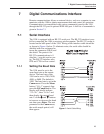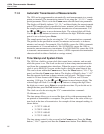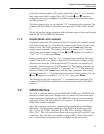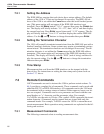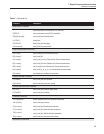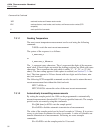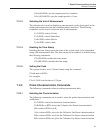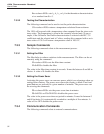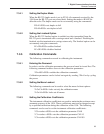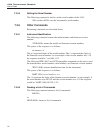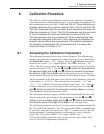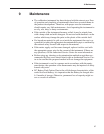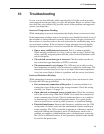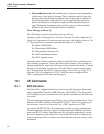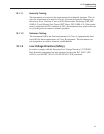
•
Stem conduction error. The problem may be that the actual temperature
of the sensor is not what you expect. This is often the result of stem con
-
duction where heat flowing through the stem of the probe to ambient af
-
fects the temperature of the probe. It is very important that immersion
probes be inserted to an adequately depth into the material being mea
-
sured. Measuring temperature using a surface sensor can be especially
difficult as the sensor is directly exposed to ambient.
Error Message at Power Up
The 1504 reports an error during the power up self-test.
On power up the 1504 performs a self-test of several of its key components. A
failure of a component will cause an error message to be displayed such as “Err
4”. The possible error messages and their meanings are as follows:
Err 1Static RAM failure.
Err 2Nonvolatile RAM failure.
Err 3Internal data structure error.
Err 4ADC initialization failure.
Err 5ADC operation error.
Generally, each of these conditions require a qualified factory technician to re-
place a faulty component. Contact the factory for assistance. One possible ex-
ception might be if a large static discharge nearby disturbs the circuits. Cycling
the power off and back on again may allow the 1504 to resume normal opera-
tion. Another might be if the AC source voltage is incorrect, e.g. using 115 V
when the 1504 is configured for 230 V. Check the source voltage and the
1504’s configuration and make sure they agree.
10.1 CE Comments
10.1.1 EMC Directive
Hart Scientifics’ equipment has been tested to meet the European Electromag
-
netic Compatibility Directive (EMC Directive, 89/336/EEC). The Declaration
of Conformity for your instrument lists the specific standards to which the unit
was tested.
The instrument was designed specifically as a test and measuring device. Com
-
pliance to the EMC directive is through IEC 61326-1 Electrical equipment for
measurement, control and laboratory use – EMC requirements (1998).
As noted in the IEC 61326-1, the instrument can have varying configurations.
The instrument was tested in a typical configuration with shielded, grounded
probe and RS-232 cables. Emissions may, in non-typical applications, exceed
the levels required by the standard. It is not practical to test all configurations,
as the manufacturer has no control over the probes the user may connect to the
instrument.
1504 Thermometer Readout
User’s Guide
40



